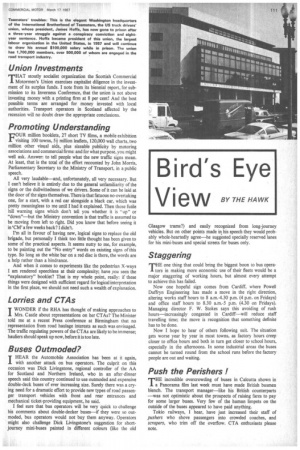Bird's Eye
Page 121

If you've noticed an error in this article please click here to report it so we can fix it.
ViewBY THE HAWK
Teamsters' troubles: This is the elegant Washington headquarters of the International Brotherhood of Teamsters, the US truck drivers' union, whose president, James Hoffa, has now gone to prison after a three-year struggle against a conspiracy conviction and eightyear sentence. Hoffa became president of this union, the largest labour organization in the United States, in 1957 and will continue to draw his annual 000,000 salary while in prison. The union has 1,700,000 members, over 500,000 of whom are engaged in the road transport industry.
Union Investments
THAT stoutly socialist organization the Scottish Commercial 1 Motormen's Union exercises capitalist diligence in the investment of its surplus funds. I note from its biennial report, for submission to its Inverness Conference, that the union is not above investing money with a printing firm at 8 per cent! And the best possible terms are arranged for money invested with local authorities. Transport operators in Scotland affected by the recession will no doubt draw the appropriate conclusions.
Promoting Understanding
'COUR million booklets, 27 short TV films, a mobile exhibition visiting 100 towns, 5+ million leaflets, 120,000 wall charts, two million other visual aids, plus sizeable publicity by motoring associations and commercial firms: and for what purpose, you might well ask. Answer: to tell people what the new traffic signs mean. At least, that is the total of the effort recounted by John Morris, Parliamentary Secretary to the Ministry of Transport, in a public speech.
All very laudable—and, unfortunately, all very necessary. But I can't believe it is entirely due to the general unfamiliarity of the signs or the dullwittedness of we drivers. Some of it can be laid at the door of the signs themselves. There is that fatuous no-overtaking one, for a start, with a red car alongside a black car, which was pretty meaningless to me until I had it explained. Then those futile hill warning signs which don't tell you whether it is -up" or "down"—but the Ministry convention is that traffic is assumed to be moving from left to right. Did you know that before seeing it in 'CM' a few weeks back? I didn't.
I'm all in favour of having new, logical signs to replace the old brigade, but personally I think too little thought has been given to some of the practical aspects. It seems nutty to me, for example, to be painting out the "No entry" words on existing signs of this type. So long as the white bar on a red disc is there, the words are a help rather than a hindrance.
And when it comes to experiments like the pedestrian X-ways I am rendered speechless at their complexity; have you seen the "explanatory" booklet? That is my whole point, really: if these things were designed with sufficient regard for logical interpretation in the first place, we should not need such a wealth of explanation.
Lorries and CTAs
T WONDER if the RHA has thought of making approaches to 1 Mrs. Castle about representations on her CTAs? The Minister told me at a recent Press conference at Birmingham that no representation from road haulage interests as such was envisaged. The traffic regulating powers of the CTAs are likely to be immense; hauliers should speak up now, before it is too late.
Buses Outmoded?
T HEAR the Automobile Association has been at it again, 1 with another attack on bus operators. The culprit on this occasion was Dick Livingstone, regional controller of the AA for Scotland and Northern Ireland, who in an after-dinner speech said this country continued to use outmoded and expensive double-deck buses of ever increasing size. Surely there was a crying need for a dramatic effort to provide new types of road passenger transport vehicles with front and rear entrances and mechanical ticket-providing equipment, he said.
I feel sure that bus operators will be very quick to challenge his comments about double-decker buses—if they were so outmoded, bus operators would not buy them anyway. Operators might also challenge Dick Livingstone's suggestion for shortjourney mini-buses painted in different colours (like the old
Glasgow trams?) and easily recognized from long-journey vehicles. But on other points made in his speech they would probably whole-heartedly agree—he suggested specially reserved lanes for his mini-buses and special streets for buses only.
Staggering
HE one thing that could bring the biggest boon to bus opera tors in making more economic use of their fleets would be a major staggering of working hours, but almost every attempt to achieve this has failed.
Now one hopeful sign comes from Cardiff, where Powell Duffryn Engineering has made a move in the right direction, altering works staff hours to 8 a.m.-4.30 p.m. (4 p.m. on Fridays) and office staff hours to 8.30 a.m.-5 p.m. (4.30 on Fridays). Managing director F. W. Stokes says this avoiding of rush hours—increasingly congested in Cardiff—will reduce staff travelling time; the move is recognition that something definite has to be done.
Now I hope to hear of others following suit. The situation gets worse year by year in most towns, as factory hours creep closer to office hours and both in turn get closer to school hours, especially in the afternoons. In some industrial areas the buses cannot be turned round from the school runs before the factory people are out and waiting.
Push the Perishers !
THE incredible overcrowding of buses in Calcutta shown in a Panorama film last week must have made British busmen blench. The transport manager—like his British counterparts --was not optimistic about the prospects of raising fares to pay for some larger buses. Very few of the human limpets on the outside of the buses appeared to have paid anything.
Tokio railways, I hear, have just increased their staff of pushers who shove passengers into crowded coaches, and scrapers, who trim off the overflow. CTA enthusiasts please note.








































































































































































































